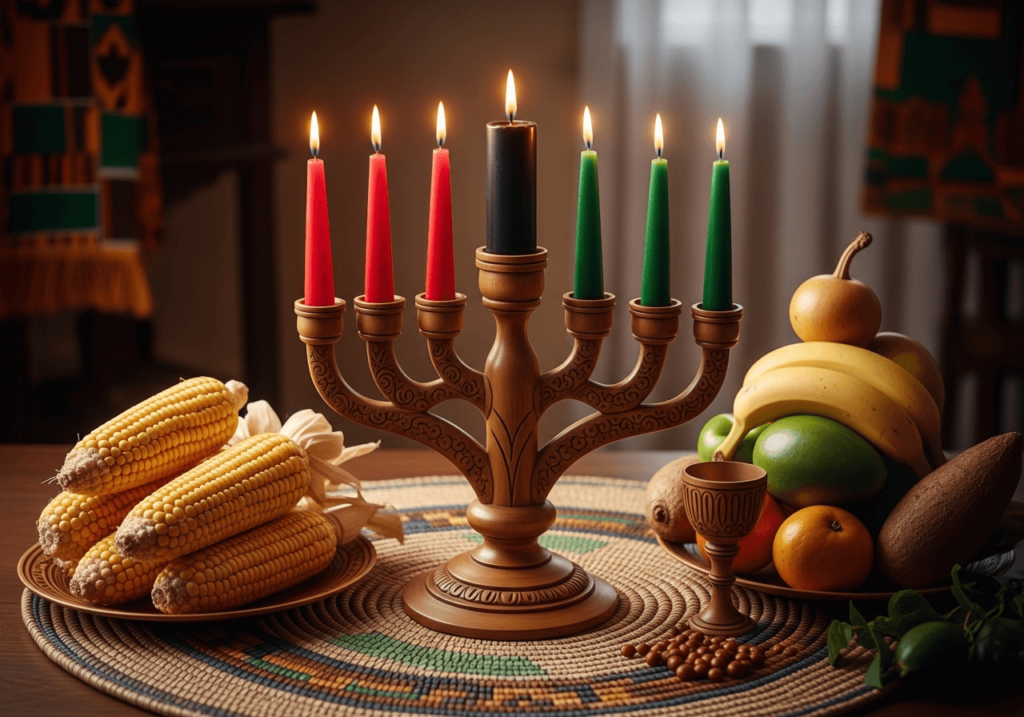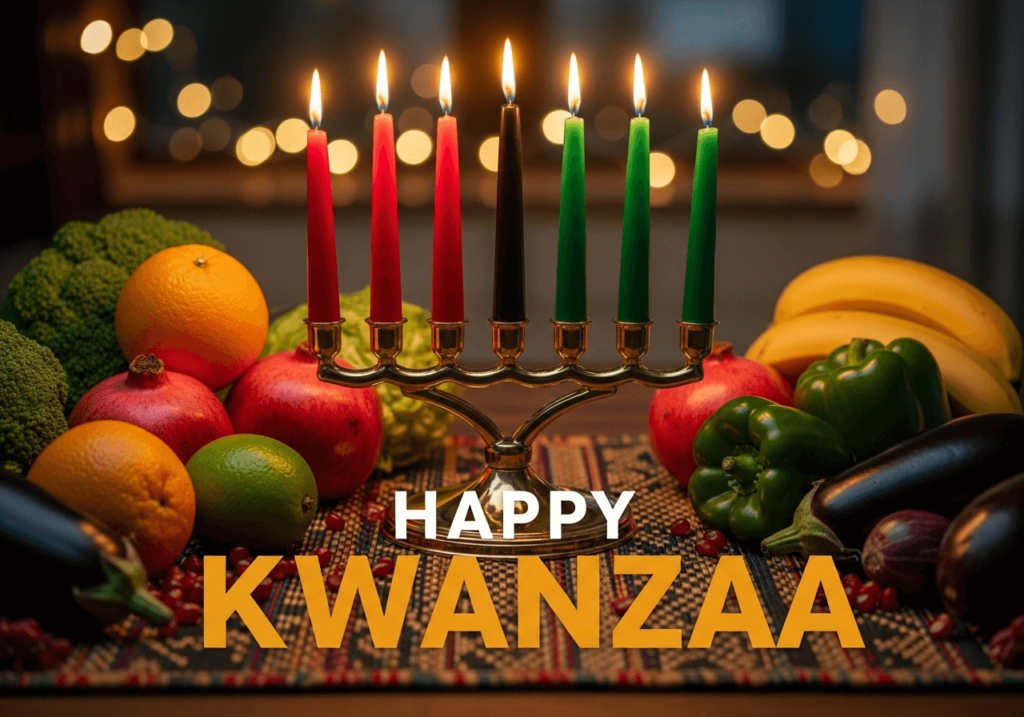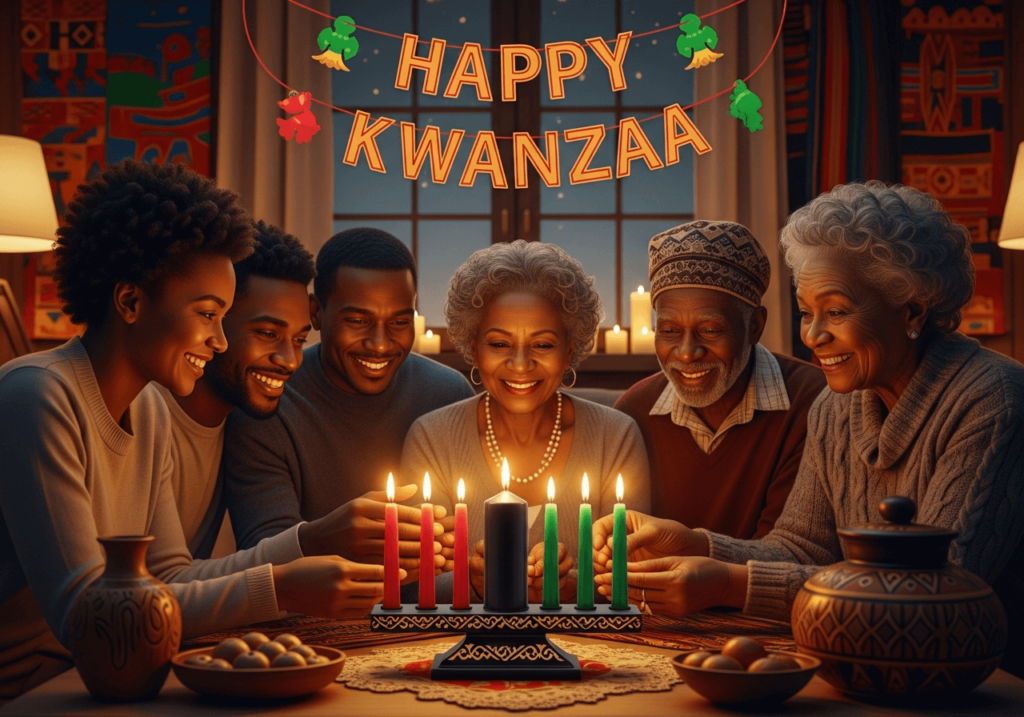Happy Kwanzaa | Greetings, Images & Meaning
Kwanzaa is a non-religious holiday that celebrates African heritage, culture, community, and unity. It takes place between December 26th and January 1st. Kwanzaa was created in the United States, but it has also been adopted by the African diaspora in other countries.
“Happy Kwanzaa” or “Joyous Kwanzaa” are two greetings used to wish someone a good Kwanzaa. If you’re writing Kwanzaa wishes, use QuillBot’s free Paraphraser to help you find just the right words and tone.
What is Kwanzaa?
Kwanzaa is a secular celebration of African culture. People celebrate Kwanzaa by having communal feasts, lighting candles, decorating their homes with African art, dressing in African fashions, playing African music, dancing, and honoring their communities.
The holiday was created in 1966 by activist and professor Maulana Karenga. Karenga wanted Blacks to have an opportunity to reaffirm and celebrate their African cultural heritage instead of only adopting the traditions of the dominant societies they found themselves in.
When is Kwanzaa?
Kwanzaa takes place between December 26th and January 1st. Unlike other holidays (e.g., Easter or Ramadan), the dates of Kwanzaa never change.
On December 31st, the sixth day of Kwanzaa, celebrants observe Karamu, a communal feast that combines a large meal with expressions of African culture, usually through music, art, storytelling, and dance.
Who celebrates Kwanzaa?
Kwanzaa is mostly celebrated by African-Americans in the United States, but it is also celebrated by people in countries like Canada, France, Jamaica, and Brazil. Since Kwanzaa is derived from African traditions, most people who celebrate it are part of the African diaspora.
What are the 7 principles of Kwanzaa?
Kwanzaa lasts seven days, and each day highlights one of the seven principles of Kwanzaa (nguzo saba in Swahili). Each night, celebrants light a candle to honor one of these principles, which are usually referred to by their Swahili names.
| Principle | Pronunciation | Translation | Meaning |
|---|---|---|---|
| Umoja | oo-MOH-jah | Unity | To work towards and maintain unity in the family, community, nation, and race |
| Kujichagulia | koo-jee-chah-guh-LEE-yah | Self-determination | To define, name, create for, and speak for ourselves |
| Ujima | oo-JEE-mah | Collective work | To build and maintain our community together; to help our community solve their problems as if they were our own |
| Ujamaa | oo-JAH-mah | Cooperative economics | To build and maintain our own businesses and to profit from them collectively |
| Nia | nee-YAH | Purpose | To view developing our community as a collective vocation that works towards restoring our people to greatness |
| Kuumba | koo-OOM-bah | Creativity | To do whatever we can to leave our community more beautiful than how we found it |
| Imani | ee-MAH-nee | Faith | To believe in our people and the righteousness and victory of our struggle |
Some other symbols of Kwanzaa are:
- Mkeka (mat on which other symbols are placed)
- Mazao (crops)
- Mahindi (corn)
- Kikombe cha Umoja (a “unity cup” for giving thanks)
- Zawadi (gifts)
Want to learn more about these Kwanzaa symbols? Ask QuillBot’s AI Chat.
Happy Kwanzaa greetings
Want to wish someone a Happy Kwanzaa? Here are some phrases you can use for different types of Kwanzaa greetings.
Short and simple Kwanzaa greetings
These short and simple Happy Kwanzaa greetings are perfect for quick notes or texts.
- Happy Kwanzaa!
- Joyous Kwanzaa!
- Wishing you a blessed Kwanzaa.
- Warm Kwanzaa wishes to you and your family!
- Have a meaningful Kwanzaa.
- Sending you lots of love and joy this Kwanzaa!
Swahili Kwanzaa greetings
Swahili is a widely spoken language in East Africa and the language chosen to express the principles and symbols of Kwanzaa. Find Swahili greetings (and translations) below.
- Heri za Kwanzaa! (Happy Kwanzaa!)
- Habari gani? (What’s the news?)*
- Harambee! (Let’s all pull together!)
*Despite its literal meaning, “Habari gani?” is a typical greeting used during Kwanzaa. The correct way to respond to this greeting is to reply with the Kwanzaa principle of the day.
Elijah: Habari gani?
Jada: Ujima! Joyous Kwanzaa!
Kwanzaa greetings with a cultural emphasis
If you want to instill your Happy Kwanzaa greetings with a stronger cultural emphasis, try one of these wishes.
- Habari gani? Wishing you a joyful Kwanzaa!
- Wishing you light and unity this Kwanzaa!
- May the Seven Principles guide you this Kwanzaa.
- Celebrating Umoja and community with you this Kwanzaa.
- May your Kwanzaa be filled with reflection, purpose, and joy.
- May Imani lead us and Umoja connect us all this Kwanzaa.
- Let’s keep Nia close this Kwanzaa and remember what we’re working towards.
- Wishing all our brothers and sisters a warm, united, and purposeful Kwanzaa!
- I hope Kujichagulia guides you this Kwanzaa towards strengthening your voice.
Happy Kwanzaa images
Sending a Happy Kwanzaa image is another way to wish someone a nice Kwanzaa, especially when sending an email or preparing a card or poster.
Below are a few Happy Kwanzaa images generated by QuillBot’s free AI image generator (plus the prompts used to create them). You can also create your own images using this tool.
Happy Kwanzaa image with traditional symbols
This image features traditional symbols of Kwanzaa, like the kinara and mkeka.
Prompt: “Happy Kwanzaa greeting image featuring a kinara with seven glowing candles (three red, three green, and one black), a woven mkeka mat, fruits and vegetables symbolizing the harvest, and bold ‘Happy Kwanzaa’ text, with warm ambient lighting.”
Happy Kwanzaa image:
Happy Kwanzaa image with minimalist pattern
If you want a more minimalist Happy Kwanza image, try using a bold, Afrocentric background.
Prompt: “Vector-style Afrocentric pattern background with geometric shapes in red, green, and black. Include centered ‘Happy Kwanzaa’ text. Place the text in a black box and render the text in a golden color.”
Happy Kwanzaa image:
Happy Kwanzaa image featuring family
This family-focused Happy Kwanzaa image highlights the community and unity that the holiday celebrates.
Prompt: “Warm, cozy scene of a family gathered around a kinara during Kwanzaa (with 7 candles: 1 black in the middle, 3 red and green on each side), soft lighting, traditional decor, and a ‘Happy Kwanzaa’ banner hanging behind the family.”
Happy Kwanzaa image:
Frequently asked questions about Happy Kwanzaa
- How many people celebrate Kwanzaa?
-
It’s not clear exactly how many people celebrate Kwanzaa, but surveys estimate that in the United States, it may be between 500,000 and 12,000,000.
Kwanzaa is also celebrated by people in countries with African diaspora populations (e.g., Canada, France, and Jamaica), though there aren’t official statistics about how many people from these countries celebrate it.
QuillBot’s AI Chat can help you learn more about Kwanzaa and who celebrates it.
- What does Kwanzaa mean?
-
Kwanzaa comes from the Swahili phrase matunda ya kwanza (“first fruits”). Kwanzaa’s name reflects the fact that its creator based it on African harvest traditions.
He also added an extra “a” to reflect Kwanzaa’s seven principles, celebrated across seven days from December 26 to January 1.
Kwanzaa’s meaning comes from its seven principles: unity, self-determination, collective work, cooperative economics, purpose, creativity, and faith.
Curious about other aspects of Kwanzaa? Ask QuillBot’s AI Chat.
- How long is Kwanzaa?
-
Kwanzaa is seven days long. It starts on December 26th and ends on January 1st.
Each of the seven days of Kwanzaa is dedicated to one of its seven principles: unity, self-determination, collective work, cooperative economics, purpose, creativity, and faith.
On the sixth day, people celebrate Karamu, a large communal feast that often features African music, dancing, and other cultural expressions.
Discover more about Kwanzaa with QuillBot’s AI Chat.
Cite this Quillbot article
We encourage the use of reliable sources in all types of writing. You can copy and paste the citation or click the "Cite this article" button to automatically add it to our free Citation Generator.
Santoro, K. (2025, November 18). Happy Kwanzaa | Greetings, Images & Meaning. Quillbot. Retrieved November 18, 2025, from https://quillbot.com/blog/wishes-and-expressions/happy-kwanzaa/





